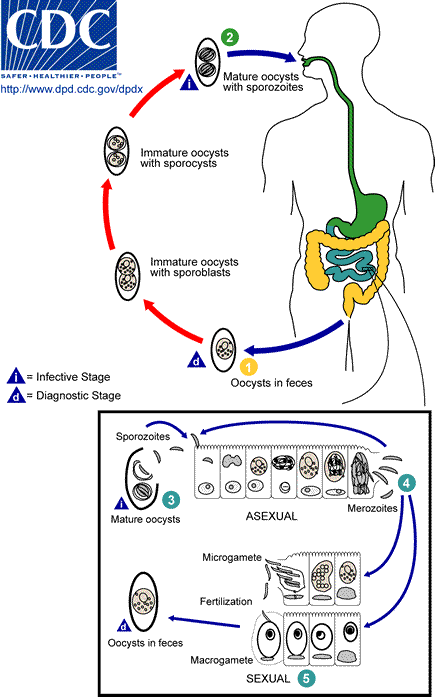Cystoisosporiasis (formerly known as isosporiasis) is an intestinal disease of humans caused by the coccidian parasite Cystoisospora belli (formerly known as Isospora belli). Cystoisosporiasis is most common in tropical and subtropical areas of the world. The parasite can be spread by ingesting contaminated food or water. The most common symptom is watery diarrhea. The infection is treatable and preventable.
Cystoisosporiasis is an intestinal disease caused by the microscopic parasite Cystoisospora belli. This is the same parasite that used to be called Isospora belli. The parasite can be spread by ingesting food or water that was contaminated with feces from an infected person.
Cystoisospora can be found worldwide. It is most common in tropical and subtropical areas.
People become infected by swallowing mature parasites, for example, by ingesting contaminated food or water. Infected people shed the immature form of the parasite in their feces. The parasite usually needs about 1 or 2 days in the environment (outside of people) to mature enough to infect someone else. In some settings, the parasite might mature in less than a day.
Cystoisospora usually is spread indirectly, such as through contaminated food or water. This is because the parasite needs time to mature. However, oral-anal contact with an infected person might pose a risk for transmission.
The most common symptom is watery diarrhea. Other symptoms can include abdominal pain, cramps, loss of appetite, nausea, vomiting, and fever. If untreated, people with weak immune systems, such as people with AIDS, may be at higher risk for severe or prolonged illness.
Cystoisospora is too small to be seen without a microscope. The infection is diagnosed by examining stool (fecal) specimens under a microscope. More than one specimen may need to be examined to find the parasite.
The infection is treated with prescription antibiotics. The usual treatment is with trimethoprim-sulfamethoxazole, which is also known as Bactrim, Septra, or Cotrim. People who have diarrhea should also rest and drink plenty of fluids.
Avoiding food or water that might be contaminated with stool may help prevent infection. As always, good handwashing and personal-hygiene practices should be followed. Wash your hands with soap and warm water after using the toilet, changing diapers, and before handling food. Teach children the importance of washing hands to prevent infection.
The coccidian parasite, Cystoisospora belli, infects the epithelial cells of the small intestine, and is the least common of the three intestinal coccidia that infect humans (the other two are CyclosporaandCryptosporidium species).

At the time of excretion in stool, the oocyst is immature and usually contains just one sporoblast (sometimes, two). During further maturation after excretion, the sporoblast divides in two (the oocyst now contains two sporoblasts); the sporoblasts secrete a cyst wall, thus becoming sporocysts; and the sporocysts divide twice, resulting in four sporozoites per each of two sporocysts. Infection occurs by ingestion of mature (fully sporulated) oocysts: the sporocysts excyst in the small intestine and release their sporozoites, which invade the epithelial cells and initiate schizogony. Upon rupture of the schizonts, merozoites are released, which invade epithelial cells and continue the cycle of asexual multiplication. Trophozoites develop into schizonts, which contain multiple merozoites. After a minimum of one week, the sexual stage begins, with the development of male and female gametocytes. Fertilization results in the development of oocysts, which are excreted in the stool.
Life cycle image and information courtesy of DPDx.
http://www.cdc.gov/parasites/For more information view the source:Center for Disease Control
http://www.cdc.gov/parasites/For more information view the source:Center for Disease Control
Recommended Test:Full GI Panel
Recommended Product:Freedom Cleanse Restore Parasite Cleanse